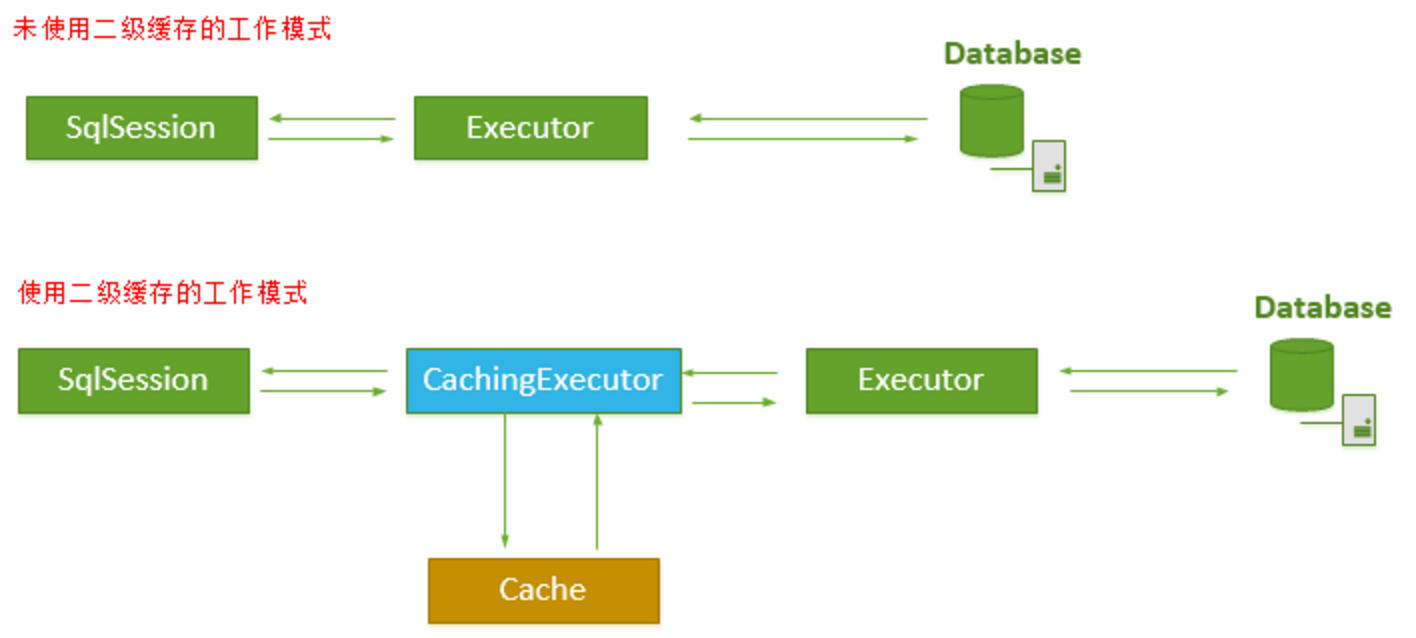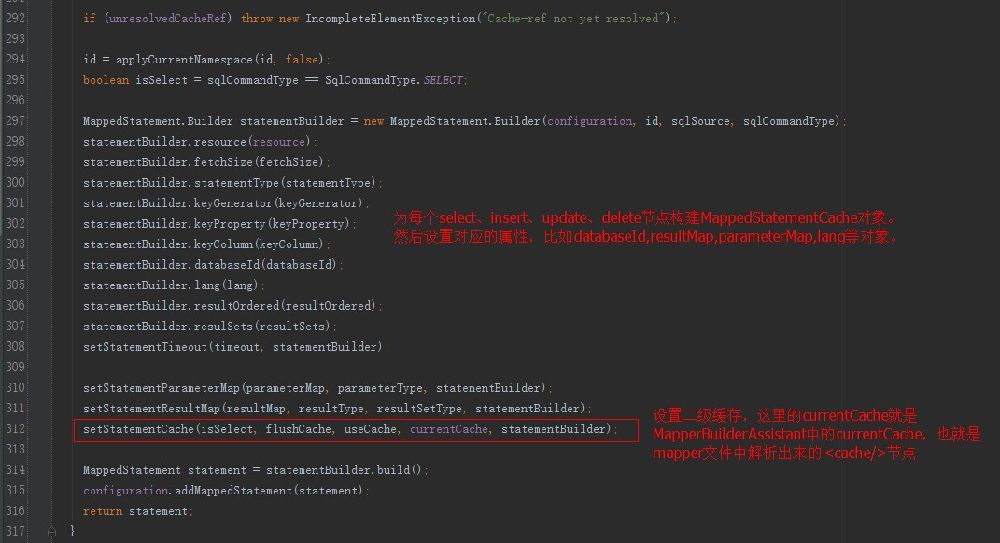1 缓存介绍
MyBatis支持声明式数据缓存(declarative data caching)。当一条SQL语句被标记为“可缓存”后,首次执行它时从数据库获取的所有数据会被存储在一段高速缓存中,今后执行这条语句时就会从高速缓存中读取结果,而不是再次命中数据库。MyBatis提供了默认下基于```Java HashMap的缓存实现,以及用于与OSCache、Ehcache、Hazelcast和Memcached连接的默认连接器。MyBatis还提供API供其他缓存实现使用。
重点的那句话就是:MyBatis执行SQL语句之后,这条语句就是被缓存,以后再执行这条语句的时候,会直接从缓存中拿结果,而不是再次执行SQL。
这也就是大家常说的MyBatis一级缓存,一级缓存的作用域scope是SqlSession。MyBatis同时还提供了一种全局作用域global scope的缓存,这也叫做二级缓存,也称作全局缓存。
MyBatis将数据缓存设计成两级结构,分为一级缓存、二级缓存:
一级缓存是Session会话级别的缓存,位于表示一次数据库会话的SqlSession对象之中,又被称之为本地缓存。一级缓存是MyBatis内部实现的一个特性,用户不能配置,默认情况下自动支持的缓存,用户没有定制它的权利(不过这也不是绝对的,可以通过开发插件对它进行修改);
二级缓存是Application应用级别的缓存,它的是生命周期很长,跟Application的声明周期一样,也就是说它的作用范围是整个Application应用。
MyBatis中一级缓存和二级缓存的组织如下图所示:

2 一级缓存
一级缓存的工作机制:
一级缓存是Session会话级别的,一般而言,一个SqlSession对象会使用一个Executor对象来完成会话操作,Executor对象会维护一个Cache缓存,以提高查询性能。关于一级缓存的详细实现,可参见MyBatis一级缓存实现。
2.1 缓存测试
同个session进行两次相同查询:
@Testpublic void test() {SqlSession sqlSession = sqlSessionFactory.openSession();try {User user = (User)sqlSession.selectOne("org.format.mybatis.cache.UserMapper.getById", 1);log.debug(user);User user2 = (User)sqlSession.selectOne("org.format.mybatis.cache.UserMapper.getById", 1);log.debug(user2);} finally {sqlSession.close();}}
MyBatis只进行1次数据库查询:
==> Preparing: select * from USERS WHERE ID = ?==> Parameters: 1(Integer)<== Total: 1User{id=1, name='format', age=23, birthday=Sun Oct 12 23:20:13 CST 2014}User{id=1, name='format', age=23, birthday=Sun Oct 12 23:20:13 CST 2014}
同个session进行两次不同的查询:
@Testpublic void test() {SqlSession sqlSession = sqlSessionFactory.openSession();try {User user = (User)sqlSession.selectOne("org.format.mybatis.cache.UserMapper.getById", 1);log.debug(user);User user2 = (User)sqlSession.selectOne("org.format.mybatis.cache.UserMapper.getById", 2);log.debug(user2);} finally {sqlSession.close();}}
MyBatis进行两次数据库查询:
==> Preparing: select * from USERS WHERE ID = ?==> Parameters: 1(Integer)<== Total: 1User{id=1, name='format', age=23, birthday=Sun Oct 12 23:20:13 CST 2014}==> Preparing: select * from USERS WHERE ID = ?==> Parameters: 2(Integer)<== Total: 1User{id=2, name='FFF', age=50, birthday=Sat Dec 06 17:12:01 CST 2014}
不同session,进行相同查询:
@Testpublic void test() {SqlSession sqlSession = sqlSessionFactory.openSession();SqlSession sqlSession2 = sqlSessionFactory.openSession();try {User user = (User)sqlSession.selectOne("org.format.mybatis.cache.UserMapper.getById", 1);log.debug(user);User user2 = (User)sqlSession2.selectOne("org.format.mybatis.cache.UserMapper.getById", 1);log.debug(user2);} finally {sqlSession.close();sqlSession2.close();}}
MyBatis进行了两次数据库查询:
==> Preparing: select * from USERS WHERE ID = ?==> Parameters: 1(Integer)<== Total: 1User{id=1, name='format', age=23, birthday=Sun Oct 12 23:20:13 CST 2014}==> Preparing: select * from USERS WHERE ID = ?==> Parameters: 1(Integer)<== Total: 1User{id=1, name='format', age=23, birthday=Sun Oct 12 23:20:13 CST 2014}
同个session,查询之后更新数据,再次查询相同的语句:
@Testpublic void test() {SqlSession sqlSession = sqlSessionFactory.openSession();try {User user = (User)sqlSession.selectOne("org.format.mybatis.cache.UserMapper.getById", 1);log.debug(user);user.setAge(100);sqlSession.update("org.format.mybatis.cache.UserMapper.update", user);User user2 = (User)sqlSession.selectOne("org.format.mybatis.cache.UserMapper.getById", 1);log.debug(user2);sqlSession.commit();} finally {sqlSession.close();}}
更新操作之后缓存会被清除:
==> Preparing: select * from USERS WHERE ID = ?==> Parameters: 1(Integer)<== Total: 1User{id=1, name='format', age=23, birthday=Sun Oct 12 23:20:13 CST 2014}==> Preparing: update USERS SET NAME = ? , AGE = ? , BIRTHDAY = ? where ID = ?==> Parameters: format(String), 23(Integer), 2014-10-12 23:20:13.0(Timestamp), 1(Integer)<== Updates: 1==> Preparing: select * from USERS WHERE ID = ?==> Parameters: 1(Integer)<== Total: 1User{id=1, name='format', age=23, birthday=Sun Oct 12 23:20:13 CST 2014}
很明显,结果验证了一级缓存的概念,在同个SqlSession中,查询语句相同的sql会被缓存,但是一旦执行新增或更新或删除操作,缓存就会被清除。
2.2 源码分析
在分析MyBatis的一级缓存之前,我们先简单看下MyBatis中几个重要的类和接口:
org.apache.ibatis.session.Configuration类:MyBatis全局配置信息类 org.apache.ibatis.session.SqlSessionFactory接口:操作SqlSession的工厂接口,具体的实现类是DefaultSqlSessionFactory org.apache.ibatis.session.SqlSession接口:执行sql,管理事务的接口,具体的实现类是DefaultSqlSession org.apache.ibatis.executor.Executor接口:sql执行器,SqlSession执行sql最终是通过该接口实现的,常用的实现类有SimpleExecutor和CachingExecutor,这些实现类都使用了装饰者设计模式
一级缓存的作用域是SqlSession,那么我们就先看一下SqlSession的select过程:
- 这是DefaultSqlSession(SqlSession接口实现类,MyBatis默认使用这个类)的selectList源码(我们例子上使用的是selectOne方法,调用selectOne方法最终会执行selectList方法):
public <E> List<E> selectList(String statement, Object parameter, RowBounds rowBounds) {try {MappedStatement ms = configuration.getMappedStatement(statement);List<E> result = executor.query(ms, wrapCollection(parameter), rowBounds, Executor.NO_RESULT_HANDLER);return result;} catch (Exception e) {throw ExceptionFactory.wrapException("Error querying database. Cause: " + e, e);} finally {ErrorContext.instance().reset();}}
- 我们看到SqlSession最终会调用Executor接口的方法。接下来我们看下DefaultSqlSession中的executor接口属性具体是哪个实现类。DefaultSqlSession的构造过程(DefaultSqlSessionFactory内部):
private SqlSession openSessionFromDataSource(ExecutorType execType, TransactionIsolationLevel level, boolean autoCommit) {Transaction tx = null;try {final Environment environment = configuration.getEnvironment();final TransactionFactory transactionFactory = getTransactionFactoryFromEnvironment(environment);tx = transactionFactory.newTransaction(environment.getDataSource(), level, autoCommit);final Executor executor = configuration.newExecutor(tx, execType, autoCommit);return new DefaultSqlSession(configuration, executor);} catch (Exception e) {closeTransaction(tx); // may have fetched a connection so lets call close()throw ExceptionFactory.wrapException("Error opening session. Cause: " + e, e);} finally {ErrorContext.instance().reset();}}
- 我们看到DefaultSqlSessionFactory构造DefaultSqlSession的时候,Executor接口的实现类是由Configuration构造的:
public Executor newExecutor(Transaction transaction, ExecutorType executorType, boolean autoCommit) {executorType = executorType == null ? defaultExecutorType : executorType;executorType = executorType == null ? ExecutorType.SIMPLE : executorType;Executor executor;if (ExecutorType.BATCH == executorType) {executor = new BatchExecutor(this, transaction);} else if (ExecutorType.REUSE == executorType) {executor = new ReuseExecutor(this, transaction);} else {executor = new SimpleExecutor(this, transaction);}if (cacheEnabled) {executor = new CachingExecutor(executor, autoCommit);}executor = (Executor) interceptorChain.pluginAll(executor);return executor;}
Executor根据ExecutorType的不同而创建,最常用的是SimpleExecutor,本文的例子也是创建这个实现类。 最后我们发现如果cacheEnabled这个属性为true的话,那么executor会被包一层装饰器,这个装饰器是 CachingExecutor。其中cacheEnabled这个属性是mybatis总配置文件中settings节点中cacheEnabled子节点的值,默认就是true,也就是说我们在mybatis总配置文件中不配cacheEnabled的话,它也是默认为打开的。
- 现在,问题就剩下一个了,CachingExecutor执行sql的时候到底做了什么?带着这个问题,我们继续走下去(CachingExecutor的query方法):
public <E> List<E> query(MappedStatement ms, Object parameterObject, RowBounds rowBounds, ResultHandler resultHandler, CacheKey key, BoundSql boundSql) throws SQLException {Cache cache = ms.getCache();if (cache != null) {flushCacheIfRequired(ms);if (ms.isUseCache() && resultHandler == null) {ensureNoOutParams(ms, parameterObject, boundSql);if (!dirty) {cache.getReadWriteLock().readLock().lock();try {@SuppressWarnings("unchecked")List<E> cachedList = (List<E>) cache.getObject(key);if (cachedList != null) return cachedList;} finally {cache.getReadWriteLock().readLock().unlock();}}List<E> list = delegate.<E> query(ms, parameterObject, rowBounds, resultHandler, key, boundSql);tcm.putObject(cache, key, list); // issue #578. Query must be not synchronized to prevent deadlocksreturn list;}}return delegate.<E>query(ms, parameterObject, rowBounds, resultHandler, key, boundSql);}
其中Cache cache = ms.getCache();这句代码中,这个cache实际上就是个二级缓存,由于我们没有开启二级缓存(二级缓存的内容下面会分析),因此这里执行了最后一句话。这里的delegate也就是SimpleExecutor,SimpleExecutor没有Override父类的query方法,因此最终执行了SimpleExecutor的父类BaseExecutor的query方法。
- 所以一级缓存最重要的代码就是BaseExecutor的query方法!
public <E> List<E> query(MappedStatement ms, Object parameter, RowBounds rowBounds, ResultHandler resultHandler, CacheKey key, BoundSql boundSql) throws SQLException {ErrorContext.instance().resource(ms.getResource()).activity("executing a query").object(ms.getId());if (closed) throw new ExecutorException("Executor was closed.");if (queryStack == 0 && ms.isFlushCacheRequired()) {clearLocalCache();}List<E> list;try {queryStack++;list = resultHandler == null ? (List<E>) localCache.getObject(key) : null;if (list != null) {handleLocallyCachedOutputParameters(ms, key, parameter, boundSql);} else {list = queryFromDatabase(ms, parameter, rowBounds, resultHandler, key, boundSql);}} finally {queryStack--;}if (queryStack == 0) {for (DeferredLoad deferredLoad : deferredLoads) {deferredLoad.load();}deferredLoads.clear(); // issue #601if (configuration.getLocalCacheScope() == LocalCacheScope.STATEMENT) {clearLocalCache(); // issue #482}}return list;}
BaseExecutor的属性localCache是个PerpetualCache类型的实例,PerpetualCache 类是实现了MyBatis的Cache缓存接口的实现类之一,内部有个Map 类型的属性用来存储缓存数据。 这个localCache的类型在BaseExecutor内部是写死的。 这个localCache就是一级缓存!
- 接下来我们看下为何执行新增或更新或删除操作,一级缓存就会被清除这个问题。首先MyBatis处理新增或删除的时候,最终都是调用update方法,也就是说新增或者删除操作在MyBatis眼里都是一个更新操作。我们看下DefaultSqlSession的update方法:
public int update(String statement, Object parameter) {try {dirty = true;MappedStatement ms = configuration.getMappedStatement(statement);return executor.update(ms, wrapCollection(parameter));} catch (Exception e) {throw ExceptionFactory.wrapException("Error updating database. Cause: " + e, e);} finally {ErrorContext.instance().reset();}}
很明显,这里调用了CachingExecutor的update方法:
public int update(MappedStatement ms, Object parameterObject) throws SQLException {flushCacheIfRequired(ms);return delegate.update(ms, parameterObject);}
这里的flushCacheIfRequired方法清除的是二级缓存,我们之后会分析。 CachingExecutor委托给了(之前已经分析过)SimpleExecutor的update方法,SimpleExecutor没有 Override父类BaseExecutor的update方法,因此我们看BaseExecutor的update方法:
public int update(MappedStatement ms, Object parameter) throws SQLException {ErrorContext.instance().resource(ms.getResource()).activity("executing an update").object(ms.getId());if (closed) throw new ExecutorException("Executor was closed.");clearLocalCache();return doUpdate(ms, parameter);}
- 我们看到了关键的一句代码: clearLocalCache(); 进去看看:
public void clearLocalCache() {if (!closed) {localCache.clear();localOutputParameterCache.clear();}}
没错,就是这条,sqlsession没有关闭的话,进行新增、删除、修改操作的话就是清除一级缓存,也就是SqlSession的缓存。
3 二级缓存
二级缓存的作用域是全局,换句话说,二级缓存已经脱离SqlSession的控制了。二级缓存的作用域是全局的,二级缓存在SqlSession关闭或提交之后才会生效。
在分析MyBatis的二级缓存之前,我们先简单看下MyBatis中一个关于二级缓存的类(其他相关的类和接口之前已经分析过):
org.apache.ibatis.mapping.MappedStatement: MappedStatement类在Mybatis框架中用于表示XML文件中一个sql语句节点,即一个、或者标签。Mybatis框架在初始化阶段会对XML配置文件进行读取,将其中的sql语句节点对象化为一个个MappedStatement对象。
二级缓存的工作机制:
一个SqlSession对象会使用一个Executor对象来完成会话操作,MyBatis的二级缓存机制的关键就是对这个Executor对象做文章。如果用户配置了”cacheEnabled=true”,那么MyBatis在为SqlSession对象创建Executor对象时,会对Executor对象加上一个装饰者:CachingExecutor,这时SqlSession使用CachingExecutor对象来完成操作请求。CachingExecutor对于查询请求,会先判断该查询请求在Application级别的二级缓存中是否有缓存结果,如果有查询结果,则直接返回缓存结果;如果缓存中没有,再交给真正的Executor对象来完成查询操作,之后CachingExecutor会将真正Executor返回的查询结果放置到缓存中,然后在返回给用户。
MyBatis的二级缓存设计得比较灵活,你可以使用MyBatis自己定义的二级缓存实现;你也可以通过实现org.apache.ibatis.cache.Cache接口自定义缓存;也可以使用第三方内存缓存库,如Memcached等。


3.1 缓存配置
二级缓存跟一级缓存不同,一级缓存不需要配置任何东西,且默认打开。 二级缓存就需要配置一些东西。本文就说下最简单的配置,在mapper文件上加上这句配置即可。其实二级缓存跟3个配置有关:
- mybatis全局配置文件中的setting中的cacheEnabled需要为true(默认为true,不设置也行)
- mapper配置文件中需要加入节点
- mapper配置文件中的select节点需要加上属性useCache需要为true(默认为true,不设置也行)
3.2 缓存测试
不同SqlSession,查询相同语句,第一次查询之后commit SqlSession:
@Testpublic void testCache2() {SqlSession sqlSession = sqlSessionFactory.openSession();SqlSession sqlSession2 = sqlSessionFactory.openSession();try {String sql = "org.format.mybatis.cache.UserMapper.getById";User user = (User)sqlSession.selectOne(sql, 1);log.debug(user);// 注意,这里一定要提交。 不提交还是会查询两次数据库sqlSession.commit();User user2 = (User)sqlSession2.selectOne(sql, 1);log.debug(user2);} finally {sqlSession.close();sqlSession2.close();}}
MyBatis仅进行了一次数据库查询:
==> Preparing: select * from USERS WHERE ID = ?==> Parameters: 1(Integer)<== Total: 1User{id=1, name='format', age=23, birthday=Sun Oct 12 23:20:13 CST 2014}User{id=1, name='format', age=23, birthday=Sun Oct 12 23:20:13 CST 2014}
不同SqlSession,查询相同语句,第一次查询之后close SqlSession:
@Testpublic void testCache2() {SqlSession sqlSession = sqlSessionFactory.openSession();SqlSession sqlSession2 = sqlSessionFactory.openSession();try {String sql = "org.format.mybatis.cache.UserMapper.getById";User user = (User)sqlSession.selectOne(sql, 1);log.debug(user);sqlSession.close();User user2 = (User)sqlSession2.selectOne(sql, 1);log.debug(user2);} finally {sqlSession2.close();}}
MyBatis仅进行了一次数据库查询:
==> Preparing: select * from USERS WHERE ID = ?==> Parameters: 1(Integer)<== Total: 1User{id=1, name='format', age=23, birthday=Sun Oct 12 23:20:13 CST 2014}User{id=1, name='format', age=23, birthday=Sun Oct 12 23:20:13 CST 2014}
不同SqlSesson,查询相同语句。 第一次查询之后SqlSession不提交:
@Testpublic void testCache2() {SqlSession sqlSession = sqlSessionFactory.openSession();SqlSession sqlSession2 = sqlSessionFactory.openSession();try {String sql = "org.format.mybatis.cache.UserMapper.getById";User user = (User)sqlSession.selectOne(sql, 1);log.debug(user);User user2 = (User)sqlSession2.selectOne(sql, 1);log.debug(user2);} finally {sqlSession.close();sqlSession2.close();}}
MyBatis执行了两次数据库查询:
==> Preparing: select * from USERS WHERE ID = ?==> Parameters: 1(Integer)<== Total: 1User{id=1, name='format', age=23, birthday=Sun Oct 12 23:20:13 CST 2014}==> Preparing: select * from USERS WHERE ID = ?==> Parameters: 1(Integer)<== Total: 1User{id=1, name='format', age=23, birthday=Sun Oct 12 23:20:13 CST 2014}
3.3 源码分析
- XMLMappedBuilder(解析每个mapper配置文件的解析类,每一个mapper配置都会实例化一个XMLMapperBuilder类)的解析方法:
private void configurationElement(XNode context) {try {String namespace = context.getStringAttribute("namespace");if (namespace.equals("")) {throw new BuilderException("Mapper's namespace cannot be empty");}builderAssistant.setCurrentNamespace(namespace);cacheRefElement(context.evalNode("cache-ref"));cacheElement(context.evalNode("cache"));parameterMapElement(context.evalNodes("/mapper/parameterMap"));resultMapElements(context.evalNodes("/mapper/resultMap"));sqlElement(context.evalNodes("/mapper/sql"));buildStatementFromContext(context.evalNodes("select|insert|update|delete"));} catch (Exception e) {throw new BuilderException("Error parsing Mapper XML. Cause: " + e, e);}}
cacheElement()
- 我们看到了解析cache的那段代码:
private void cacheElement(XNode context) throws Exception {if (context != null) {String type = context.getStringAttribute("type", "PERPETUAL");Class<? extends Cache> typeClass = typeAliasRegistry.resolveAlias(type);String eviction = context.getStringAttribute("eviction", "LRU");Class<? extends Cache> evictionClass = typeAliasRegistry.resolveAlias(eviction);Long flushInterval = context.getLongAttribute("flushInterval");Integer size = context.getIntAttribute("size");boolean readWrite = !context.getBooleanAttribute("readOnly", false);Properties props = context.getChildrenAsProperties();builderAssistant.useNewCache(typeClass, evictionClass, flushInterval, size, readWrite, props);}}
- 解析完cache标签之后会
使用builderAssistant的userNewCache方法,这里的builderAssistant是一个MapperBuilderAssistant类型的帮助类,每个XMLMappedBuilder构造的时候都会实例化这个属性,MapperBuilderAssistant类内部有个Cache类型的currentCache属性,这个属性也就是mapper配置文件中 cache节点所代表的值:
public Cache useNewCache(Class<? extends Cache> typeClass,Class<? extends Cache> evictionClass,Long flushInterval,Integer size,boolean readWrite,Properties props) {typeClass = valueOrDefault(typeClass, PerpetualCache.class);evictionClass = valueOrDefault(evictionClass, LruCache.class);Cache cache = new CacheBuilder(currentNamespace).implementation(typeClass).addDecorator(evictionClass).clearInterval(flushInterval).size(size).readWrite(readWrite).properties(props).build();configuration.addCache(cache);currentCache = cache;return cache;}
builderAssistant
OK,现在mapper配置文件中的cache节点被解析到了XMLMapperBuilder实例中的builderAssistant属性中的currentCache值里。
- 接下来XMLMapperBuilder会解析select节点,解析select节点的时候使用XMLStatementBuilder进行解析(也包括其他insert,update,delete节点):
public void parseStatementNode() {String id = context.getStringAttribute("id");String databaseId = context.getStringAttribute("databaseId");if (!databaseIdMatchesCurrent(id, databaseId, this.requiredDatabaseId)) return;Integer fetchSize = context.getIntAttribute("fetchSize");Integer timeout = context.getIntAttribute("timeout");String parameterMap = context.getStringAttribute("parameterMap");String parameterType = context.getStringAttribute("parameterType");Class<?> parameterTypeClass = resolveClass(parameterType);String resultMap = context.getStringAttribute("resultMap");String resultType = context.getStringAttribute("resultType");String lang = context.getStringAttribute("lang");LanguageDriver langDriver = getLanguageDriver(lang);Class<?> resultTypeClass = resolveClass(resultType);String resultSetType = context.getStringAttribute("resultSetType");StatementType statementType = StatementType.valueOf(context.getStringAttribute("statementType", StatementType.PREPARED.toString()));ResultSetType resultSetTypeEnum = resolveResultSetType(resultSetType);String nodeName = context.getNode().getNodeName();SqlCommandType sqlCommandType = SqlCommandType.valueOf(nodeName.toUpperCase(Locale.ENGLISH));boolean isSelect = sqlCommandType == SqlCommandType.SELECT;boolean flushCache = context.getBooleanAttribute("flushCache", !isSelect);boolean useCache = context.getBooleanAttribute("useCache", isSelect);boolean resultOrdered = context.getBooleanAttribute("resultOrdered", false);// Include Fragments before parsingXMLIncludeTransformer includeParser = new XMLIncludeTransformer(configuration, builderAssistant);includeParser.applyIncludes(context.getNode());// Parse selectKey after includes and remove them.processSelectKeyNodes(id, parameterTypeClass, langDriver);// Parse the SQL (pre: <selectKey> and <include> were parsed and removed)SqlSource sqlSource = langDriver.createSqlSource(configuration, context, parameterTypeClass);String resultSets = context.getStringAttribute("resultSets");String keyProperty = context.getStringAttribute("keyProperty");String keyColumn = context.getStringAttribute("keyColumn");KeyGenerator keyGenerator;String keyStatementId = id + SelectKeyGenerator.SELECT_KEY_SUFFIX;keyStatementId = builderAssistant.applyCurrentNamespace(keyStatementId, true);if (configuration.hasKeyGenerator(keyStatementId)) {keyGenerator = configuration.getKeyGenerator(keyStatementId);} else {keyGenerator = context.getBooleanAttribute("useGeneratedKeys",configuration.isUseGeneratedKeys() && SqlCommandType.INSERT.equals(sqlCommandType))? new Jdbc3KeyGenerator() : new NoKeyGenerator();}builderAssistant.addMappedStatement(id, sqlSource, statementType, sqlCommandType,fetchSize, timeout, parameterMap, parameterTypeClass, resultMap, resultTypeClass,resultSetTypeEnum, flushCache, useCache, resultOrdered,keyGenerator, keyProperty, keyColumn, databaseId, langDriver, resultSets);}
这段代码前面都是解析一些标签的属性,我们看到了最后一行使用builderAssistant添加MappedStatement,其中builderAssistant属性是构造XMLStatementBuilder的时候通过XMLMappedBuilder传入的,我们继续看builderAssistant的addMappedStatement方法:

setStatementCache()
- 进入setStatementCache:
private void setStatementCache(boolean isSelect,boolean flushCache,boolean useCache,Cache cache,MappedStatement.Builder statementBuilder) {flushCache = valueOrDefault(flushCache, !isSelect);useCache = valueOrDefault(useCache, isSelect);statementBuilder.flushCacheRequired(flushCache);statementBuilder.useCache(useCache);statementBuilder.cache(cache);}
最终mapper配置文件中的被设置到了XMLMapperBuilder的builderAssistant属性中,XMLMapperBuilder中使用XMLStatementBuilder遍历CRUD节点,遍历CRUD节点的时候将这个cache节点设置到这些CRUD节点中,这个cache就是所谓的二级缓存!
CachingExecutor
- 接下来我们回过头来看查询的源码,CachingExecutor的query方法:
public <E> List<E> query(MappedStatement ms, Object parameterObject, RowBounds rowBounds, ResultHandler resultHandler, CacheKey key, BoundSql boundSql)throws SQLException {Cache cache = ms.getCache();if (cache != null) {flushCacheIfRequired(ms);if (ms.isUseCache() && resultHandler == null) {ensureNoOutParams(ms, parameterObject, boundSql);@SuppressWarnings("unchecked")List<E> list = (List<E>) tcm.getObject(cache, key);if (list == null) {list = delegate.<E> query(ms, parameterObject, rowBounds, resultHandler, key, boundSql);tcm.putObject(cache, key, list); // issue #578. Query must be not synchronized to prevent deadlocks}return list;}}return delegate.<E> query(ms, parameterObject, rowBounds, resultHandler, key, boundSql);}
TransactionalCacheManager
- 进入TransactionalCacheManager的putObject方法:
public void putObject(Cache cache, CacheKey key, Object value) {getTransactionalCache(cache).putObject(key, value);}private TransactionalCache getTransactionalCache(Cache cache) {TransactionalCache txCache = transactionalCaches.get(cache);if (txCache == null) {txCache = new TransactionalCache(cache);transactionalCaches.put(cache, txCache);}return txCache;}
TransactionalCache
- TransactionalCache的putObject方法:
public void putObject(Object key, Object object) {entriesToRemoveOnCommit.remove(key);entriesToAddOnCommit.put(key, new AddEntry(delegate, key, object));}
我们看到,数据被加入到了entriesToAddOnCommit中,这个entriesToAddOnCommit是什么东西呢,它是TransactionalCache的一个Map属性:
private Map<Object, AddEntry> entriesToAddOnCommit;
AddEntry
AddEntry是TransactionalCache内部的一个类:
private static class AddEntry {private Cache cache;private Object key;private Object value;public AddEntry(Cache cache, Object key, Object value) {this.cache = cache;this.key = key;this.value = value;}public void commit() {cache.putObject(key, value);}}
好了,现在我们发现使用二级缓存之后:查询数据的话,先从二级缓存中拿数据,如果没有的话,去一级缓存中拿,一级缓存也没有的话再查询数据库。有了数据之后在丢到TransactionalCache这个对象的entriesToAddOnCommit属性中。
接下来我们来验证为什么SqlSession commit或close之后,二级缓存才会生效这个问题。
- DefaultSqlSession的commit方法:
public void commit(boolean force) {try {executor.commit(isCommitOrRollbackRequired(force));dirty = false;} catch (Exception e) {throw ExceptionFactory.wrapException("Error committing transaction. Cause: " + e, e);} finally {ErrorContext.instance().reset();}}
- CachingExecutor的commit方法:
public void commit(boolean required) throws SQLException {delegate.commit(required);tcm.commit();dirty = false;}
- tcm.commit即 TransactionalCacheManager的commit方法:
public void commit() {for (TransactionalCache txCache : transactionalCaches.values()) {txCache.commit();}}
- TransactionalCache的commit方法:
public void commit() {delegate.getReadWriteLock().writeLock().lock();try {if (clearOnCommit) {delegate.clear();} else {for (RemoveEntry entry : entriesToRemoveOnCommit.values()) {entry.commit();}}for (AddEntry entry : entriesToAddOnCommit.values()) {entry.commit();}reset();} finally {delegate.getReadWriteLock().writeLock().unlock();}}
- 发现调用了AddEntry的commit方法:
public void commit() {cache.putObject(key, value);}
发现了! AddEntry的commit方法会把数据丢到cache中,也就是丢到二级缓存中!
关于为何调用close方法后,二级缓存才会生效,因为close方法内部会调用commit方法。本文就不具体说了。 读者有兴趣的话看一看源码就知道为什么了。
4 Cache接口
org.apache.ibatis.cache.Cache是MyBatis的缓存接口,想要实现自定义的缓存需要实现这个接口。MyBatis中关于Cache接口的实现类也使用了装饰者设计模式。我们看下它的一些实现类:

简单说明:
LRU – 最近最少使用的:移除最长时间不被使用的对象。 FIFO – 先进先出:按对象进入缓存的顺序来移除它们。 SOFT – 软引用:移除基于垃圾回收器状态和软引用规则的对象。 WEAK – 弱引用:更积极地移除基于垃圾收集器状态和弱引用规则的对象。
<cacheeviction="FIFO" <!-- 可以通过cache节点的eviction属性设置,也可以设置其他的属性。-->flushInterval="60000"size="512"readOnly="true"/>
cache-ref节点:mapper配置文件中还可以加入cache-ref节点,它有个属性namespace。如果每个mapper文件都是用cache-ref,且namespace都一样,那么就代表着真正意义上的全局缓存。如果只用了cache节点,那仅代表这个这个mapper内部的查询被缓存了,其他mapper文件的不起作用,这并不是所谓的全局缓存。

